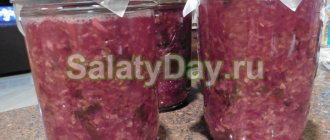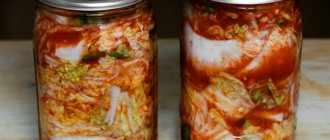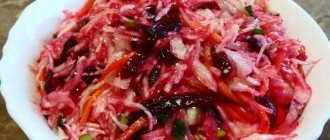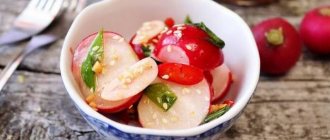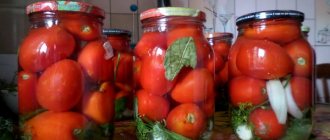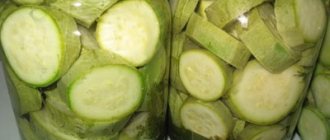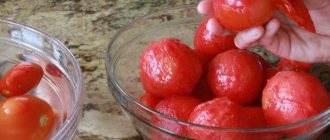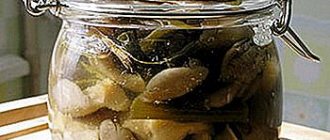Differences from fermentation and pickling
Attention : There is no big difference between pickling and pickling. In both methods, salt creates the conditions for lactic acid fermentation. The difference is that, in fact, pickling is the first part of fermentation, but in it the process of lactic acid fermentation stops at the initial stage.
But there is a big difference between salting and marinating. Pickling is a method of canning that uses strong brine to preserve the product for a long time. When salting, foods continue to live in a special biosphere of enzymes and fungi, while in a marinade, all living things die. Thus, when salting, products retain their properties better .
Basics of cooking technology
To properly salt cabbage, you need to have certain knowledge.
They apply to all salting methods, regardless of flavoring additives:
- “Late” cabbage is used, which ripened right before frost.
It will have minimal sugar content. - For a sweet note in taste, it is customary to add grated carrots, but you can do without it.
- Cabbage is salted in a jar, enamel bucket or wooden tub. It is better not to use plastic containers.
- The required amount of salt is calculated as follows: for every 20 kilograms of cabbage, 400 grams of salt will be used. You can do a little more, but not less.
- A load is placed on top of the cabbage compacted in the container so that it releases the juice. It is advisable to drain the excess liquid into a separate jar, and place the future snack in a cold place.
- When the cabbage is completely ready (usually this period does not exceed 3-4 days), add the juice back.
The benefits of salted red cabbage vegetables
Purple cabbage contains more vitamin A than regular cabbage (you can find out how red cabbage differs from white cabbage here). And by eating 200 g of this vegetable, you will provide your body with 89% of the daily requirement of vitamin C. It also contains much more fiber than the same cabbage. A large amount of anthocyanin, a natural antioxidant that fights cancer, normalizes the number of leukocytes in the blood, strengthens blood vessels, and prevents premature aging.
Cabbage also contains:
- vitamins K, E, PP, group B;
- phosphorus;
- magnesium;
- potassium;
- calcium;
- iodine;
- copper;
- silicon;
- iron;
- manganese;
- amino acids;
- phytoncides;
- carbohydrates;
- Sahara;
- enzymes;
- bioflavonoids.
Thus, red cabbage has a positive effect on blood pressure, thyroid function, and kidney function . This vegetable contains a lot of non-digestible dietary fiber, so it keeps you feeling full for a long time.
Cabbage contains 20 kcal per 100 grams, 2 grams of protein, 0 grams of fat, 6 grams of carbohydrates.
Read in detail about the benefits of red cabbage and the possible harm from eating the vegetable here, and from this article you will learn about which varieties of red cabbage are the best.
Beneficial properties of red cabbage
Despite the fact that the cruciferous plant comes from countries with a Mediterranean climate, it tolerates the weather conditions of the middle zone, but in Russia it is cultivated much less than white cabbage, but the composition of the vegetable is much richer. The unusual coloring of the leaves is due to anthocyanins. These substances help increase the strength of the walls of blood vessels, reduce blood pressure in patients with hypertension, and remove toxins and radionuclides from the body.
Red cabbage contains selenium, which has a beneficial effect on the thyroid gland and accelerates the synthesis of antibodies. Fiber normalizes the digestion process and cleanses the intestines of fats and toxins. Ascorbic acid strengthens the immune system. Phytoncides present in the leaves fight bacterial infection.
The juice of the vegetable, which in Russia was called blue cabbage, has long been used to treat tuberculosis, bronchitis, and stomach ulcers. The leaves of the culture were used to heal wounds, scratches, and tighten scars. Red cabbage is rich in vitamins in the form of:
- tocopherol;
- folic acid;
- riboflavin;
- retinol.
The vegetable is useful for women carrying a baby, people with diabetes, and people who suffer from obesity. With regular use, the heart functions better, cancer tumors form less, and healthy cells do not degenerate.
The purple color looks very original in a salad; the sharp and unusual taste of cabbage fermented for the winter will appeal to all household members.
Recipe in marinade
Ingredients:
- Red cabbage – 3 kg.
- Bay leaf – 5-6 pieces.
- Garlic – 1 small head.
- Black peppercorns – 5 peas.
- Allspice peas – 5 peas.
- Dried cloves - 5 pieces.
- Sugar – 2 tablespoons.
- Non-iodized salt - 2 tablespoons.
- Table vinegar 9% - 5 tablespoons.
- Boiled water at room temperature – 1 liter.
Cooking method:
- Prepare the cabbage by removing any damaged outer leaves.
- Chop it into strips of medium length and width.
- Peel the garlic, then cut it into thin slices.
- Mix both ingredients in a deep bowl by squeezing with your hands.
- Sterilize clean jars.
- Place the spices on the bottom of the jars first, and the cabbage and garlic on top. Try to compact the vegetables as tightly as possible.
- Marinade: Pour water into a saucepan, put on fire and bring to a boil, add sugar and salt. Boil for 2 minutes and pour in vinegar.
- Pour the finished marinade into jars with the preparation.
- Cover with lids and place for sterilization. We set half-liter jars for 15 minutes, liter jars for 30 minutes.
- After sterilization, seal the jars with lids. You can eat it every other day, ideally keep it for at least 4 days.
With horseradish and herbs
For lovers of spicy dishes, red cabbage marinated with herbs and pepper will be a real treat. The treat prepared according to this recipe is spicy, aromatic and very healthy.
Ingredients used:
- red cabbage – 2.3 kg;
- currant leaves – 12 pcs.;
- horseradish – 35 grams;
- six cloves of garlic;
- celery, parsley, tarragon - at your discretion;
- dill seeds – 10 grams;
- hot ground pepper – 12 grams;
- sugar and salt - 23 grams each;
- vinegar (6%) – 200 ml;
- water – 1.2 liters.
Cooking:
- Peel the cabbage and cut into thin strips.
- Grind the horseradish in a meat grinder, cut the garlic into small slices.
- Wash and sterilize the glass jar, then put currant leaves, chopped herbs and dill seeds into it. Place cabbage on top.
- To prepare the marinade, add salt and sugar to the water, then bring the liquid to a boil and after three minutes turn off the heat.
- Cool the filling, then add vinegar and immediately pour into a jar with cabbage.
Cool the workpiece and put it in the cold. It is recommended to try the treat after two or three days, then it will infuse and become incredibly tasty.
Spicy purple snack
Ingredients:
- Red cabbage – 1 kg.
- Beetroot – 200 – 300 g. (2 pieces).
- Carrots – 200 – 300 g. (2 pieces).
- Garlic – 4 cloves.
- Allspice peas – 3 peas.
- Black peppercorns – 3 peas.
- Hot red pepper – 1 teaspoon.
- Non-iodized salt - 2 tablespoons.
- Table vinegar 9% – 100 ml.
- Vegetable oil – 100 ml.
- Sugar – 1 glass.
- Boiled water at room temperature – 1 liter.
Cooking method:
- Chop the head of cabbage into strips approximately 3 cm wide. Place in a deep bowl.
- Grate carrots and beets using a Korean carrot grater. Add vegetables to cabbage and mix everything.
- Place into sterilized jars. Top each with pepper and chopped garlic.
- Dissolve salt and sugar in water, pour in oil and vinegar.
- Bring the mixture to a boil, stirring well. Let the marinade cool slightly, then pour into the vegetables.
- We roll up the jars with lids. You can eat it every other day, ideally wait at least 4 days.
Canned preparation “Mood”
The recipe for making red cabbage is simple but time-consuming. The finished snack is crispy and aromatic. It is recommended to serve it on the table by first watering it with a small amount of vegetable oil.
Products:
- cabbage - 1.8 kg;
- clean water - 500 ml;
- cloves - 4-5 inflorescences;
- chili - 15 g;
- laurel - 3 leaves;
- garlic - 10 cloves;
- black pepper - 4 pcs.;
- sweet peas - 3 pcs.;
- granulated sugar - 50 g;
- table salt - 50 g;
- apple bite - 100 ml.
- Peel the cabbage forks, rinse and chop into thin strips. The net weight of the product must be 1 kg. Place in a large food bowl, sprinkle with a little salt and stir. There is no need to knead, otherwise the preserves will not crunch. Cover and leave for 12 hours to form juice in the cold.
- Rinse the jars, carefully place them on a baking sheet and place them in the oven. Dry and simply boil the lids for 3 minutes.
- Rinse the hot ingredient and cut it lengthwise into 2 equal parts. Remove seeds and white partitions. Chop into strips or cubes, as you prefer. Remove the garlic cloves from the peel and cut into plastic pieces.
- Place spices, chili and garlic on the bottom of the treated containers, then compact the cabbage tightly and pour out the juice that has been released overnight.
- Now let's move on to preparing the marinade. Pour water into a saucepan, add canning salt and granulated sugar. Cook until completely dissolved.
- Remove from heat and pour in the acid and fill the container. Cover and sterilize for a quarter of an hour.
- Carefully remove the jars, roll them up, turn them over and store them in the cold.
Crispy cabbage
Ingredients:
- Red cabbage – 5 kg.
- Sugar – 100 g.
- Non-iodized salt – 100 g.
Cooking method:
- Peel the cabbage from the top leaves.
- Chop it into strips into a large, deep bowl. Add salt and sugar and mix well by squeezing it. Leave for 30 minutes.
- Then transfer the cabbage to a sterilized jar, compacting it tightly, not reaching 2 centimeters from the top of the neck.
- Cover the jar with gauze, place in a deep bowl and leave in a warm, dry place for a day.
- After a day, make several small holes in the cabbage to allow gas to escape. And leave it for another 3 days.
- After 3 days, the cabbage is ready, pour the juice accumulated in the bowl into a jar. Close the jar with a lid and place it in the refrigerator or other cool place. The cabbage is ready.
Preparing winter preparations
Red cabbage, pickled for the winter, will help diversify your daily diet and provide useful vitamins during the cold season. And thanks to fruit vinegar and specially selected seasonings, the preparation turns out to be pleasantly spicy, with a fragrant and appetizing smell.
Ingredients used:
- red cabbage – 1.8 kg;
- salt and sugar - 30 grams each;
- one carrot;
- three cloves of garlic;
- laurel leaves – 3 pcs.;
- pepper (white and black) – five peas each;
- cumin – 8 grams;
- apple cider vinegar – 170 ml;
- coriander – 20 grams.
Cooking:
- Peel the cabbage from dry or dirty leaves, rinse under running water and chop into strips.
- Peel and chop the garlic under a press, grate the carrots on a grater with large holes.
- Pour water into a cooking vessel, add all the seasonings and boil for about two minutes. Then pour in vinegar, bring to a boil and turn off the stove.
- Combine cabbage with carrots and garlic, then sprinkle with salt and stir thoroughly.
- Now place the vegetable mixture in sterile jars, compact lightly and fill with boiling marinade.
- Roll up all the blanks with iron lids, turn them upside down and place them under a blanket for two days.
Place the cooled canned food in a permanent storage place in a cool cellar. Cabbage pickled for the winter can be eaten with your favorite side dish or used to make a vinaigrette.
Purple with beets
Ingredients:
- Red cabbage – 2 kg.
- Carrots – 200 g.
- Beetroot – 150 g.
- Garlic – 1 head of garlic.
- Water – 1 liter.
- Sugar – 1/2 cup.
- Non-iodized salt - 2 tablespoons.
- Ground black pepper – 1/2 teaspoon.
- Table vinegar 9% – 1 glass (250 ml.).
- Vegetable oil – 1/2 cup (125 ml).
Cooking method:
- Chop the cabbage and place in a deep bowl.
- Grate the carrots and beets and add to the cabbage.
- Finely chop the garlic and add to the same bowl. Mix everything.
- Pour water into a saucepan, add sugar, salt and pepper. Bring to a boil and then add oil and vinegar.
- Pour hot brine over cabbage.
- Press down with a plate and leave at room temperature for 10-12 hours.
- Afterwards, put the cabbage into jars and store in the refrigerator.
Recipe for pickling purple cabbage in Bulgarian style
Not only in our country they know how to deliciously salt cabbage. Residents of sunny Bulgaria also love this product, but prepare it according to their own recipe. Thanks to barley grains, fermentation occurs faster, and the cabbage itself acquires a rather interesting taste.
It is worth noting that according to this recipe, Bulgarians do not shred the cabbage when pickling, but cut it into 4 parts, so pickling does not require much time. In this way, the fermented vegetable can be either cut for serving or made into cabbage rolls.
Attention: no matter what they say about the benefits of iodized salt, it is not suitable for fermentation, as it softens vegetables. As a result, they turn out limp and lack crunch. The same applies to sea salt, as well as the “extra” type. Use only coarse rock salt.
Cooking time: 30 minutes
Number of servings: 100
Energy value
- calorie content – 10.4 kcal;
- fats – 0 g;
- proteins – 0.8 g;
- carbohydrates – 1.8 g.
Ingredients
- red cabbage – 10 kg;
- water – 4 l;
- barley – 50 g;
- rock salt – 1 cup.
Step-by-step preparation
- Choose large cabbage. If there are damaged or dried leaves on the fork, cut them off and wash the rest. Trim the bottom of the stalk. And divide the cabbage into 4 parts from bottom to top. Throw the barley grains into a barrel or other large container, and then lay out the cabbage, center up.
- Boil the water. Stir salt in it (250 ml glass). Rock salt contains impurities, so let the brine sit and then carefully drain so that the turbidity remains at the bottom. Pour cold saline solution over the cabbage.
- Find a lid or crosspiece that can be used to press the cabbage down. Place a large rock or other heavy object on top. Keep the barrel indoors at room temperature.
- The next day, taste the brine. If it turns out too bland, the cabbage may simply turn sour. In this case, you need to prepare a little concentrated solution with salt. Drain the brine, mix it with fresh solution and pour back. If the cabbage is over-salted, then do it differently: the drained brine is gradually diluted with clean water.
- Cabbage may be unevenly salted. To prevent this from happening, during the first week you need to drain the brine once every 2 days and pour it back. Do this procedure twice during the second week, and once during the third week.
- After about a month, you can try sauerkraut in Bulgarian style. If it is not yet salted to your taste, then leave it for another 1-2 weeks. If ready, then put it in a cool place (for example, in a basement, cellar or on a glazed balcony, where the temperature can be maintained at 10-12°C). Make sure that the water always covers the cabbage, otherwise mold may appear.
Classic recipe
Ingredients:
- red cabbage – 1 head;
- non-iodized fine salt;
- 100 g butter;
- table vinegar 9% – 200 ml.
- sugar – 1 tablespoon.
Cooking method:
- Wash and sterilize jars and lids.
- Shred the cabbage into small strips and place in a large bowl.
- Add salt, a little corn or sunflower oil, mix well, squeezing the cabbage until juice appears. Leave for 2-3 hours.
- Meanwhile, in a bowl, combine sugar, vinegar and one tablespoon of salt. Stir until the solids are completely dissolved.
- Place the cabbage and spices in jars in layers, fill everything with vinegar brine, and close the lids. The workpiece should be stored in a cool place. You can try it in 3-4 days.
With sweet pepper
This preparation of red cabbage for the winter turns out tasty, aromatic and healthy. The composition is completely free of vinegar, which makes it safe for people with improper functioning of the digestive tract. The snack must be stored in a dark, cool room. For variety, you can include fresh celery stalks in the salad.
Products:
- clean water - 1 l;
- sugar - 1 glass;
- onion - 0.2 kg;
- cabbage - 1.5 kg;
- red and yellow pepper pods - 1.2 kg;
- rock salt - 3 tbsp;
- dill seeds - 1.5 tsp.
We proceed as follows:
- Rinse the cabbage forks, remove the top unedible leaves and the stalk. Chop into thin strips. Place in a large, spacious bowl, add seeds, salt and sugar. Mix thoroughly with lightly pressing movements and cover.
- Peel the onion, chop into half rings, place in a separate bowl.
- Wash the pepper, dip in boiling water and cook for 5 minutes. Carefully remove and remove the thin skin. Cut into 2 parts, remove seeds and stem, cut into slices.
- Mix the prepared vegetables with cabbage and place in sterile containers. This must be done tightly so that there is no free space in the jars. Cover and sterilize for 20 minutes. Roll up or twist, turn over and cover. Leave until completely cool.
How to make it quickly?
- Five minutes . Add fresh ginger root, grated on a fine grater, to the finished cabbage, 2-3 tablespoons per jar. A quick, original and very simple appetizer is ready.
- Lenten salad.
- Coarsely chop 4 small boiled potatoes, mix with a can of canned beans and 150 g of salted cabbage.
- Chop 50 g of pickled cucumbers and an onion, add to the rest of the ingredients.
- Season with oil, salt and pepper, mix everything and serve.
- Pies from ready-made dough with cabbage . Heat a frying pan with vegetable oil, add 400 g of salted cabbage there and fry for 15 minutes, stirring occasionally. Add 2 tablespoons of tomato paste and fry for another 5 minutes. The filling is ready, form the pies and fry on both sides.
Tip : Ready-made dishes can be served in portioned plates, garnished with herbs and a small amount of fresh vegetables.
We recommend looking at our other articles with recipes for red cabbage dishes: Korean style, as well as Czech stew.
Pickled red cabbage for the winter
Sauerkraut contains many useful substances that fresh vegetables do not have. But the purple snack is also beautiful. Add sour apples to the vegetables and prepare an excellent salad. For 3 large heads of cabbage, take:
- 1 kg green apples (sour);
- 2 large onions;
- 100 g salt (fine);
- 1 tablespoon of dill seeds.
Shred the cabbage heads into thin strips.
Peel the apples from the core and cut into thin strips.
Cut the onion into half rings.
Mix vegetables, fruits, dill seeds and salt in one container.
Fill the jars with the mixture. We put oppression on top and a bowl below for the juice that will drain during fermentation of the cabbage.
We keep the salad in the room for 2-3 days, close it with nylon lids and lower it into the basement.
Cabbage and cranberries are prepared using the same recipe, only you need to mix the vegetable with berries carefully and carefully so as not to crush the cranberry beads.
Many dishes, such as vinaigrette, bigus or dumplings, use salted cabbage. An interesting option will turn out if you take red cabbage.
Selecting and preparing cabbage
For pickling, medium-late and late varieties of vegetables are bought or planted in the garden.
Most Popular:
- GAKO 741. Medium late variety. The heads of cabbage are flat-round in shape, weighing up to 3 kg. Purple-gray leaves with a waxy coating. The taste is pungent with a slight bitterness, which disappears during long-term storage. Cabbage stays well until spring.
- Benefit F1. Mid-season hybrid with good taste. Resistant to crop diseases. Round-shaped heads of cabbage grow up to 2.5 kg. The leaves are red-violet.
- Rodima F1. Late-ripening Dutch hybrid, suitable for long-term storage and processing. Large dark red heads of cabbage grow up to 4 kg. Juicy, crispy leaves stay fresh for a long time.
- Firebird. Mid-season variety. The dense heads of cabbage have a short stalk, the leaves are bright red-violet in color and have a juicy, sweet taste.
- Varna F1. Late hybrid of Japanese selection, resistant to drought. Dark red, elongated heads of cabbage grow up to 3 kg in weight. The taste of the leaves is excellent.
Basic recommendations:
- For pickling, choose large, dense heads of cabbage.
- Remove the top leaves. Inspect the vegetable for the presence of rotten places.
- For chopping, use a wide knife or a special grater: this type of cabbage has thick and coarse leaves.
- In order for the vegetable to release juice, it is not only crushed, but also crushed with a masher.
Adviсe
Basic recommendations for preparation, rolling and storage:
- The top leaves, even if they are not spoiled, are not taken for pickling.
- For long-term storage, select glass jars of the required volume.
- Before storing, containers are thoroughly washed and sterilized.
- For short-term storage (no more than 7 days in the refrigerator), use plastic containers.
- Metal lids must be boiled for 2-3 minutes to get rid of factory grease.
- When storing pickled or salted products in the pantry, add a little vegetable oil to the vegetables: this prevents the growth of bacteria.
- The shelf life of the snack is increased by cranberries or lingonberries.
Methods for exterminating spiders in the country
- The No. 1 remedy for spider infestations in a dacha is the timely removal of leftover vegetables and fruits, fallen leaves and tops. The fact is that all these organic residues are an excellent food base for flies, beetles and other insects. Clusters of insects, in turn, are a source of food for spiders.
- It is imperative to destroy spider webs and egg-laying sites. This recommendation for exterminating spiders must be carried out using personal protective equipment, because... Spiders, and tarantulas in particular, jealously guard their future spiderlings.
- You can use raid-type poisons, but treatment from an aerosol can in an open space is unreasonably expensive, so etching is usually done with mixtures based on rethroids.
Romantic berry: a selection of the most delicious varieties of cherries for central Russia
It is important to take into account that insecticides also affect beneficial insects that pollinate plants, so it is better to carry out treatment in the late evening, when bees no longer fly to the site
- If you don’t want to purchase fairly expensive products, you can destroy spiders using a solution of boric acid, vinegar or dust. All these components are used separately and diluted with water in a ratio of 5050.
- Spiders have an excellent sense of smell, and peppermint is considered a natural "deodorant" whose scent can repel spiders.
To solve the problem of how to get rid of spiders in your summer cottage with maximum efficiency, you need to understand that spiders are not flies and mosquitoes. These are creatures of a completely different species.
- Therefore, if you take “raid”, then the packaging must indicate that the product is intended to kill spiders. Other types of dichlorvos and raids may simply stupefy the spider for a while, but it will not necessarily die.
- Sticky tapes can help catch spiders in theory. Spiders usually sit on their webs and rarely move actively. Therefore, Velcro have extremely low efficiency.
- Not every summer resident will dare to collect spiders mechanically. This is especially true for medium and large species. Of course, there will be efficiency from collecting adult spiders, but due to the fact that a mass population is not so easy to collect, the effectiveness compared to the use of insecticides is not so high as to risk being bitten.
It is worth considering for the most “desperate” that even an ordinary cross can bite more painfully than a bumblebee or a hornet, and the risk of developing an allergic reaction to a bite is many times greater.
